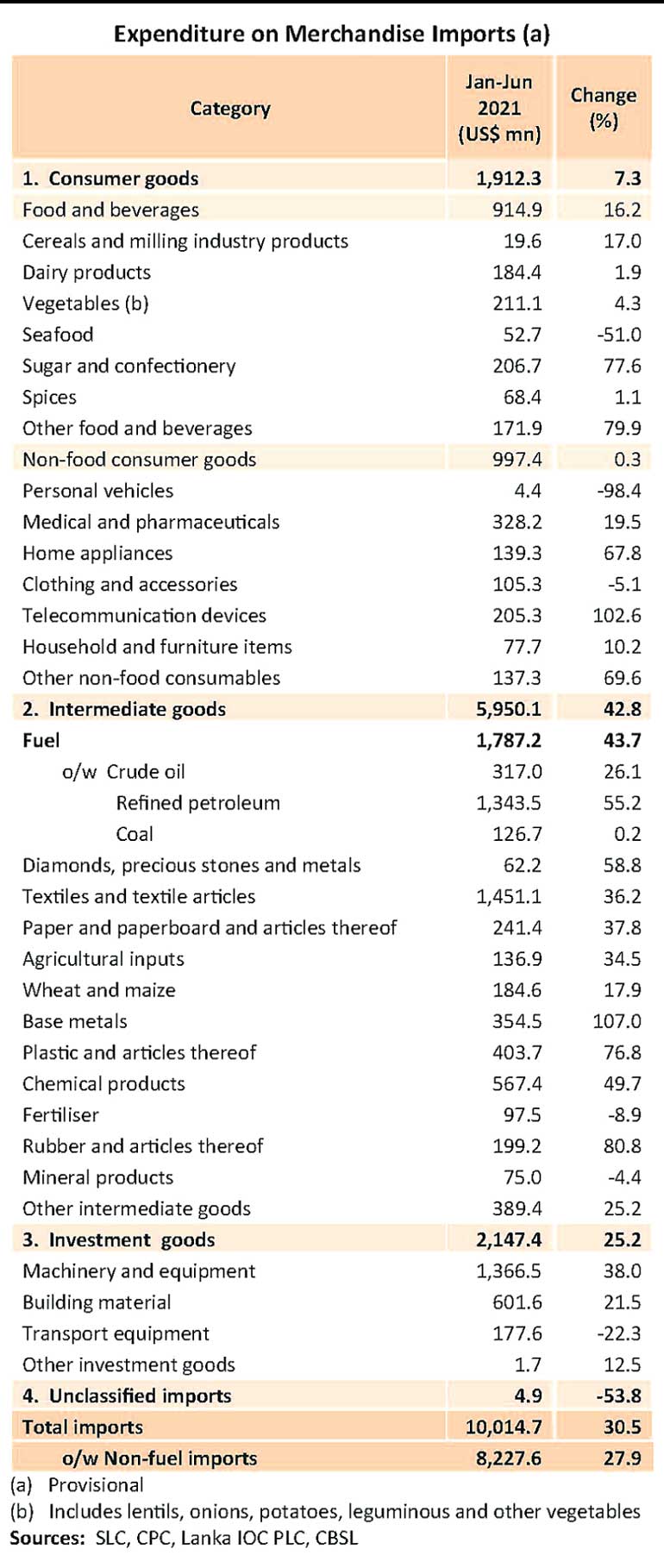Tuesday Dec 23, 2025
Tuesday Dec 23, 2025
Monday, 16 August 2021 00:00 - - {{hitsCtrl.values.hits}}

Despite ongoing restrictions, imports appear irresistible for Sri Lanka – that is judging by a strong 30% growth in the first half of this year and it crossing the $ 10 billion mark.
According to the latest external trade data released by the Central Bank, the country›s imports in the first six months ended June 2021 amounted to Rs. 10.015 billion, up 30.5% from the $ 7.67 billion figure in the corresponding period of last year.
Imports peaked at an unusually high figure of $ 1.92 billion in March, making it the highest monthly import value since March 2018.
In the first half, total expenditure on the importation of consumer goods rose by 7.3% to $ 1.9 billion and importation of intermediate goods jumped by 43% to $ 5.95 billion, while importation of investment goods rose by 25% to $ 2.14 billion.
The Central Bank estimated that imports in 2021 would grow by only 10.5% to $ 17.8 billion. The end-June figure amounts to over 60% of 2020 full year imports and 56% of the estimated value for 2021 of $ 17.8 billion. In 2020, imports declined by 19% to $ 16.1 billion from nearly $ 20 billion in 2019.
Owing to the pandemic, medical and pharmaceuticals imports were up 19.5% to $ 328 million. However, in the first half, other notable increases under the consumer goods category were sugar and confectionery (up 77% to $ 206.7 million), telecommunication devices (up 103% to $ 205 million), other food and beverages (up 80% to $ 172 million), and home appliances (up 68% to $ 139 million).
In the intermediate goods category, wheat and maize (up 18% to $ 185 million); plastic and articles thereof (up 77% to $ 404 million), base metals (up 107% to $ 354 million); chemical products (up 50% to $ 567 million) and rubber and articles thereof (up 81% to $ 199 million); and other intermediate goods (up 25% to $ 389 million). In the investment goods category, machinery and equipment imports rose by 38% to $ 1.36 billion and building material by 21% to $ 602 million.
In June, imports grew by a high 57% to $ 1.66 billion, maintaining the above $ 1.5 billion average monthly figure year to date.
The Central Bank said in June that the increase in import expenditure had been observed across all main categories of imports, namely consumer goods, intermediate goods and investment goods, although expenditure on petroleum imports was low due to low import volumes during June.
In June, expenditure on the importation of both food and beverages and non-food consumer goods categories increased substantially compared to a year ago. Expenditure on food and beverages increased by 61.9% to $ 165 million with a broad-based increase in all categories, except seafood. However, the largest contribution to the increase in total food bill was from dairy products (mainly milk powder, but also cheese and butter), and oils and fats (mainly coconut oil, but also other types of oil). Expenditure on non-food consumer goods increased by 47.6% to $ 217.2 million, contributed mainly by medical and pharmaceuticals (mainly vaccines), home appliances (televisions, rice cookers, fans, refrigerators, etc.), mobile phones, rubber tyres and tubes, etc.
Expenditure on importation of intermediate goods in June 2021 increased by 48.5% over June 2020, despite the 40% decline in the expenditure on fuel. Expenditure on fuel declined due to non-importation of crude oil and low import volumes of other types of petroleum, taking into consideration the availability of sufficient stocks. The expenditure on almost all other types of intermediate goods increased, except fertiliser, mineral products and unmanufactured tobacco, reflecting increased economic activity in the country as well as increased commodity prices in the world market.
Expenditure on importation of investment goods increased by 81% in June 2021 compared to the same month in 2020, with substantial increases in almost every subcategory under the three types of investment goods, namely, machinery and equipment, building material and transport equipment.
The import volume and unit value indices increased by 26.7% and 24%, respectively, on a year-on-year basis in June 2021. These indicate that the increase in import expenditure, on a year-on-year basis, was attributable to the combined impact of higher import volumes and prices.
Due to a sharp rise in imports, the deficit in the trade account widened on a year-on-year basis to $ 652 million in June 2021 as against $ 161 million a year ago, and the cumulative deficit in the first half widened to $ 4.3 billion from $ 3.26 billion recorded in the corresponding period in 2020 and $ 3.6 billion recorded in the corresponding period in 2019.
Earnings from merchandise exports in June grew by 12.6% to $ 1 billion and in the first half by 29% to $ 5.7 billion. In 2019 first half the figure was $ 6 billion. Over May 2021 exports improved by 13% in June.